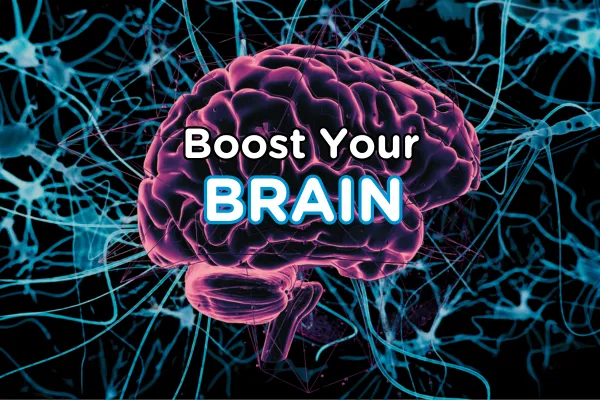General Inquiries: (587) 333-6349 - info@sanostate.com



Boost Your Brain: How Neurofeedback Improves Working Memory
Working memory plays a crucial role in everyday cognitive tasks, enabling us to perform complex activities that require active thinking and decision-making. - Alissa Van Buren
Have you ever found yourself frantically repeating a phone number in your head, fearing you'll forget it the moment you reach for your phone? Need help to recall the next step after a set of instructions? Perhaps you've wandered aimlessly through the grocery store, trying to remember what brought you there in the first place. Welcome to the world of working memory challenges. This blog will delve into working memory and its pivotal role in our daily lives, introduce strategies to sharpen it, and discuss how neurofeedback (NF) can help!
So, what exactly is working memory?
Think of working memory as a mental sticky note, a temporary holding space where your brain stores relevant information while you simultaneously engage in other tasks such as solving problems, making decisions, or following instructions. It’s a cognitive system that allows us to juggle important details, even when our attention is divided between multiple tasks. In addition to merely holding information, working memory actively manipulates it, enabling higher-order functions like reasoning, language comprehension, and problem-solving. It allows us to keep track of multiple pieces of information and mentally rearrange them to reach a solution or make sense of a complex idea.
Working memory retains information for short periods, usually lasting 10 to 20 seconds. If the information is not actively rehearsed or refreshed, it begins to decay and fade from our minds. Processes such as rehearsing information or associating information with existing knowledge, can prevent this decay and transfer the information to long-term memory through a process called consolidation. Working memory is prone to rapid forgetting without rehearsal or attending to the information.
Working memory has a limited capacity—typically, we can hold only about 4 to 7 discrete pieces of information at a time. This capacity can be extended through "chunking," where smaller pieces of information are grouped into larger, more meaningful units. For instance, remembering the sequence of numbers "5, 6, 7, 1, 2, 3" is more manageable when thought of as two chunks, "567" and "123," rather than six individual digits. After about 20 seconds, if we do not rehearse or give meaning to the information, it fades away or is replaced by new incoming data competing for space in our working memory. This makes working memory highly dynamic but also fragile. For example, imagine you meet several new people at a family wedding. If you don't actively rehearse their names a time or two in your mind or create mental associations—such as remembering who is married to whom—you’ll likely forget those names within minutes. This highlights the importance of attention and meaningful encoding in keeping information alive in working memory long enough for it to potentially become part of your long-term knowledge.
Why is it so important in our daily life?
Working memory plays a crucial role in everyday cognitive tasks, enabling us to perform complex activities that require active thinking and decision-making. Our ability to problem-solve, reason, and make decisions depends on our capacity to hold and manipulate information on a temporary basis quickly. In an academic setting, working memory is essential for tasks like math, reading comprehension, and learning new information. It helps us retain and process new data long enough for it to be encoded and transferred into long-term memory. This is particularly important when students learn new concepts, follow multi-step instructions, or solve problems requiring mental calculations.
Working memory also supports multitasking and task-switching by keeping track of different information streams, enabling us to seamlessly transition between tasks without losing focus. For instance, when following multi-step recipes or instructions, working memory allows us to focus on the sequence of actions while filtering out distractions. It helps sustain focus by supporting attentional control, allowing us to stay on task and manage interruptions.
Additionally, working memory plays a significant role in our social interactions. It aids in emotional regulation by giving us the mental space to pause, assess situations, and respond thoughtfully rather than impulsively. This ability to reflect before reacting is key to managing emotions and engaging in appropriate social behaviour. Executive functions like goal setting, impulse control, and flexible thinking also rely on working memory, as it enables us to adapt to changing circumstances and revise strategies when necessary.
Working memory acts as a mental storage system and workspace that allows us to manage daily activities, learn effectively, maintain focus, and engage in meaningful social interactions. Pretty important, right?!
What are ways we can improve our working memory?
There are various strategies and exercises that can be used to improve working memory, targeting both cognitive functioning and lifestyle factors.
Lifestyle Strategies:
Mindfulness and Meditation: Practicing mindfulness and meditation can enhance focus and attention, which in turn supports working memory. Meditating helps clear mental clutter, reduce distractions, and improve one's ability to hold and manipulate information. Learn more about Mindfulness and Meditation in our previous blogs:
Mastering Mindfulness: Your Key to Stress Relief and Well-being!
Sleep: Adequate sleep plays a crucial role in memory processing and consolidation, the process by which information is transferred from working memory to long-term memory. A well-rested brain is better equipped to retain and recall information. Learn more about Sleep and Mental Health in our previous blogs:
Unraveling Moon Mysteries: Sleep and Mood Effects
Sleep Strategies: Boost Your Mental Health in Five Simple Steps
Playing Musical Instruments: Learning and playing a musical instrument involves multitasking, such as reading music, coordinating hand movements, and processing auditory information. These activities challenge and improve working memory by engaging multiple cognitive processes.
Exercise: Physical activity boosts blood flow to the brain and promotes neuroplasticity, the brain's ability to adapt and form new connections, which is essential for enhancing working memory. Learn more about Exercise and Mental Health in our previous blogs:
Cognitive Functioning Strategies and Exercises:
Rehearsal Techniques: Techniques like chunking help by breaking information into smaller, more manageable parts, making it easier to remember. Repetition—rehearsing information mentally or out loud—reinforces memory retention.
Visualization and Mental Imagery: Creating visual associations can aid working memory by converting information into mental images. Mind mapping is another technique that visually organizes information, helping to connect and recall-related concepts.
Cognitive Training Games: Memory games that involve recalling sequences of numbers, cards, or words can gradually strengthen working memory capacity by challenging the brain to remember and process information in new ways.
Neurofeedback: This is where we can help! Let's explore how NF can specifically improve working memory below.
How can Neurofeedback help?
Neurofeedback can improve working memory by training the brain to regulate its activity more efficiently. Individuals can learn to adjust and optimize their brain functioning through real-time feedback on brainwave patterns. Since working memory and attention are closely linked, NF has been shown to enhance attention and focus. By training specific brainwave patterns associated with focused attention, NF helps individuals improve their ability to stay on task, which in turn supports working memory by allowing the brain to better hold and manipulate information without distraction.
Studies have shown that NF effectively improves both attention and working memory in individuals with ADHD by enhancing brainwave activity related to sustained attention and cognitive control. Additionally, NF can target and optimize activity in brain areas associated with working memory, such as the prefrontal cortex and parietal lobe. These regions play a critical role in short-term memory, as they are responsible for holding and processing information during complex tasks.
Executive functioning, which includes a broader set of cognitive processes like planning, task management, and goal-setting, also benefits from neurofeedback. NF improves overall executive function by enhancing neural connectivity and optimizing brainwave patterns, which is essential for effective working memory. Furthermore, NF can help reduce brain activity associated with stress and anxiety, promoting a calmer and more focused state. Since anxiety and stress can impair working memory by overloading the brain’s cognitive resources, reducing these states allows the brain to allocate more resources to working memory.
NF can be a powerful tool for improving working memory and overall cognitive functioning by training the brain to operate more effectively.
If this is an area where you could use support, connect with us HERE or by calling
587-333-6349. 💙
Disclaimer
Our content is for informational and educational purposes and is not a replacement for professional advice, diagnosis, or treatment. If you're facing mental health concerns, please seek help from a qualified professional for personalized guidance. Every individual's situation is unique, so use the information here at your discretion. While we strive for accuracy, the field of psychology is ever-evolving, and our content may not always reflect the latest research. Please prioritize your privacy by avoiding sharing personal information in comments or interactions. Your well-being is our top concern, so use our content for educational purposes, but remember to rely on professionals for your specific needs.
References
Bailey, E. (2023). Improve working memory: Brain training tricks. ADDitude. https://www.additudemag.com/improve-working-memory/
Dobrakowski, P., & Łebecka, G. (2020). Individualized neurofeedback training may help achieve long-term improvement of working memory in children with ADHD. Clinical eeg and Neuroscience, 51(2), 94-101.
Kubala, J. (2023). 14 natural ways to improve your memory. Healthline. https://www.healthline.com/nutrition/ways-to-improve-memory
Wang, J. R., & Hsieh, S. (2013). Neurofeedback training improves attention and working memory performance. Clinical Neurophysiology, 124(12), 2406-2420.
YuLeung To, E., Abbott, K., Foster, D. S., & Helmer, D. A. (2016). Working memory and neurofeedback. Applied Neuropsychology: Child, 5(3), 214-222.
General Inquiries:
Our Locations:
Additional Resources:
About Us:
We strive for excellence in psychological treatment. We are committed to providing professional, caring, innovative, and research-based services.
© 2024 Sano State Taylored Psychology. All Rights Reserved.

